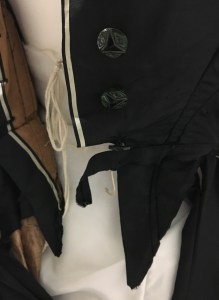Not a terribly exciting or very original title, I know: maybe I can think of a better one. In this series, I’ll take one garment and look carefully at its textiles, trim, and construction details, including evidence of alterations made to keep up with new trends, or much later changes made for dress-up. (So many 18th century dresses, for example, were worn for Colonial Revival or Centennial or other commemorative events like pageants, parades, or “Martha Washington Teas,” that they often have 19th or early 20th century alterations which are pretty easy to spot.)

I hope that these closeups with commentary will be interesting, especially to anyone who uses historic clothing in his or her work or hobby. If you are a collector, it may help date antique dresses you see for sale. If you go to costume exhibitions in museums and leave wondering about more than the label tells you, these will give you something extra. If you are a costumer who is frustrated by books and exhibits’ lack of interior photos, and online databases’ lack of details on construction… I think you will enjoy this series. If you write fiction set in other periods, perhaps this will be enlightening.

I welcome suggestions and requests on this series. What should I choose first–a dress from what decade (1770s-1910s)? What would you like me to mention as I look at these dresses? I have a lineup of several garments in the DAR Museum collection I’d like to talk about, but I’ve got no particular order to go in, so I’m willing to crowdsource my posts.
I love most fashions between 1770- 1910 with the exception of the so called Romantic era of 1825-1840. I do find altered clothing to be fascinating. I came to historical fashion via Pinterest- I know, I’m sorry! – but have bought a number of books about the subject now. A dress made of silk in the 18th century and remade several times until about 1860 intrigues me. Why? Was the material too good to waste? Did it have sentimental memories attached to it? I would love you to do an article about a repurposed dress or dress fabric.
LikeLike
Don’t apologize! It’s great how internet and social media has opened people to new vistas. hooray! The materials before Industrial revolution were indeed too good to waste. Very few early 18c dresses survive as such because the construction was such that they were easy to pick out the stitches and reconfigure into later styles (really, the 18c had a limited # of styles: Mantua, sack back, and fitted back until c 1775-80 when you get the pieced back which is a variation on the fitted back, and the chemise/drawstring dress). In the 1840s the heavier silks, and 18c silk floral designs, were back in fashion so you see some 18c silks remade into ball dresses. Yes, I do need to do a post on this! Thanks for your “vote.”
LikeLike